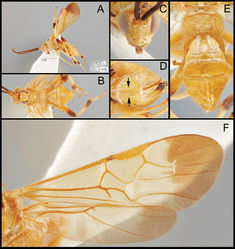Schoenlandella gloriosa
| Notice: | This page is derived from the original publication listed below, whose author(s) should always be credited. Further contributors may edit and improve the content of this page and, consequently, need to be credited as well (see page history). Any assessment of factual correctness requires a careful review of the original article as well as of subsequent contributions.
If you are uncertain whether your planned contribution is correct or not, we suggest that you use the associated discussion page instead of editing the page directly. This page should be cited as follows (rationale):
Citation formats to copy and paste
BibTeX: @article{Kang2021JournalofHymenopteraResearch86, RIS/ Endnote: TY - JOUR Wikipedia/ Citizendium: <ref name="Kang2021Journal of Hymenoptera Research86">{{Citation See also the citation download page at the journal. |
Ordo: Hymenoptera
Familia: Braconidae
Genus: Schoenlandella
Name
Schoenlandella gloriosa Mercado & Wharton, 2003 – Wikispecies link – Pensoft Profile
Material examined
Paratypes: Mexico • 1♀; 3 mi E Papantla, Veracruz, Mexico; 7 Jun. 1965; leg. Burke, Meyer, Schaffner • 1♀; 2 mi SE Tecpan de Galeana, Guerrero, Mexico; 14 Jul. 1966; leg. P.M and P.K Wagner • 2♂; Hotel Covandonga, 12 km S Valles, Ruta 85, San Luis Potosi, Mexico; 27–29 Jun. 1981; leg. C. Porter, L. Stange. Deposited in TAMU. Non-type material: Costa Rica • 1♀; 10 km NW Cañas, Mojica, Guanacaste, Costa Rica; 26 Sep.–10 Oct. 2011; leg. P. Hanson. Deposited in MICR. Honduras • 1♀; Tela, Lancetilla, Atlántida, Honduras; 15°43'N, 87°27'W; 30 Apr. 1995; leg. R. Cave. 1♀; same as previous except for the collecting date, 15 May. 1995. 1♂; same as previous except the collecting date, 31 Aug. 1995. Deposited in HNHM.
Diagnosis
Members of the S. gloriosa are nearly identical to S. diaphaniae. The following combination of characters differentiate S. gloriosa from S. diaphaniae: face concave; malar space relatively elongate (~0.50 × longer than height of eye in anterior view) (Fig. 2C); two clypeal tubercles with smooth margins (Fig. 2C); forewing basally yellow and apically infuscate; stigma entirely pale; forewing with junction of angled Rs not swollen (Fig. 2F).
Description
Modified from Mercado and Wharton (2003)[1], including additional characters.
Body 5.5–8.0 mm. Head: Antenna 32–34-segmented. Eye length ~0.41 × longer than its height (35:85) in lateral view. Dorsal width of lower face ~1.05 × longer than height of lower face (79:75). Clypeus 1.20–1.53 × longer than its width, two clypeal tubercles with smooth margin (Fig. 2C). Malar space 0.47–0.50 × longer than height of eye in anterior view (35:75–40:80), 2.75–3.42 × longer than basal width of mandible (33:12–41:12). Galea 1.30–1.40 × longer than malar length as viewed laterally (43:33–56:40) (Fig. 2A). Mesosoma: Scutellar sulcus with 5–7 crenulae. Propodeum with median transverse carina reaching lateral margin. Pronotum weakly carinate medially. Mesopleuron mostly smooth; precoxal sulcus smooth, not reaching posterior margin. Legs: Basal spur on mid tibia 0.83–0.90 × mid-basitarsus length. Hind femur medially 0.31–0.32 × broader than its length (52:164–48:155). Wings: Forewing: maximum width of second submarginal cell ~2.26× longer than maximum length (113:50); 3r absent; Rs vein angled at basal fourth (Fig. 2F). Hind wing 2–1A present as basal stump (Fig. 2F). Metasoma: Medial length of T1 2.00–2.47 × longer than medial length of T2 (78:39–75:30). Medial length of T2 0.21–0.26 × longer than its apical width (30:140–39:149). T3 about 1.46–1.60 × longer than T2 medially (57:39–48:30). Hypopygium evenly sclerotized, median longitudinal fold absent (Note: A weakly depressed medial longitudinal area is present in females collected in Honduras, but never membranous and folded) (Fig. 2D). Ovipositor moderately downcurved. Protruded ovipositor sheaths moderately downcurved, 0.45–0.50 × longer than hind tibia, broadened apically, anteriorly depilous and moderately pilose apically with long setae.
Color
See Mercado and Wharton (2003)[1]. Melanic areas of the Costa Rican specimen (female) and Mexican specimens are slightly darker than specimens collected in Honduras.
Male
See Mercado and Wharton (2003)[1].
Host
Unknown.
Distribution
Costa Rica, Honduras, and Mexico.
Taxon Treatment
- Kang, I; Sharkey, M; Diaz, R; 2021: Revision of the genus Schoenlandella (Hymenoptera, Braconidae, Cardiochilinae) in the New World, with a potential biological control agent for a lepidopteran pest of bitter gourd (Momordica charantia L.) Journal of Hymenoptera Research, 86: 47-61. doi
Images
|
Other References
- ↑ 1.0 1.1 1.2 Mercado I, Wharton R (2003) Mexican cardiochiline genera (Hymenoptera: Braconidae), including a preliminary assessment of species-groups in Toxoneuron Say and Retusigaster Dangerfield, Austin and Whitfield.Journal of Natural History37(7): 845–902. https://doi.org/10.1080/00222930110097167
